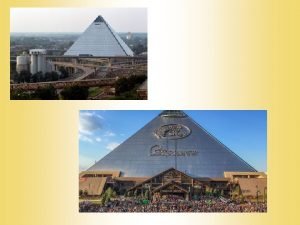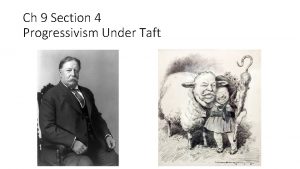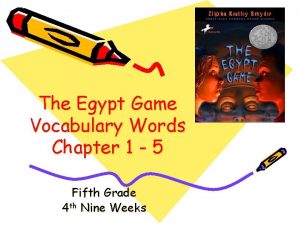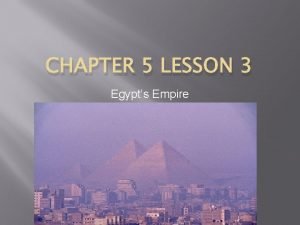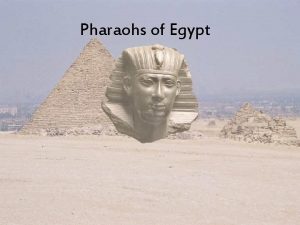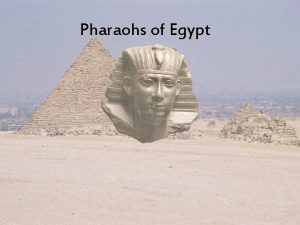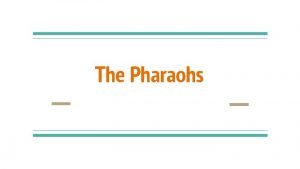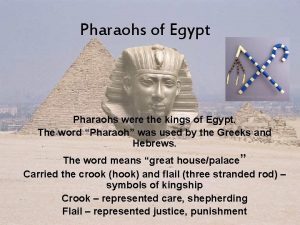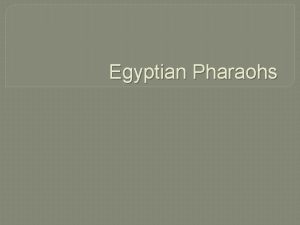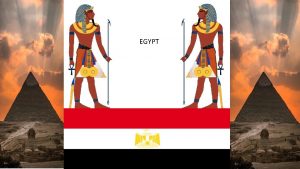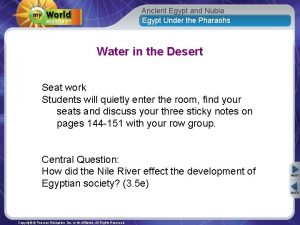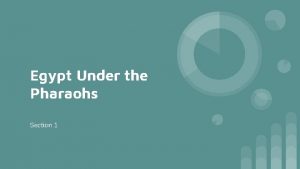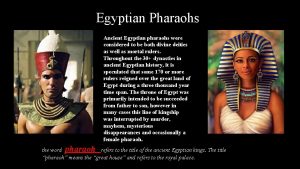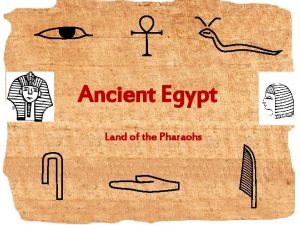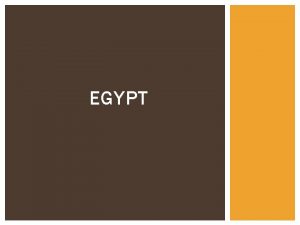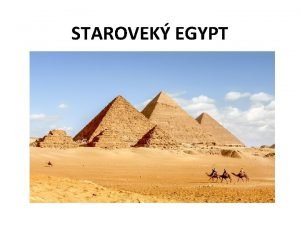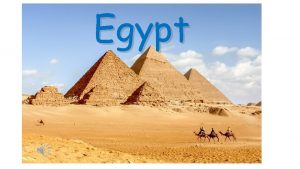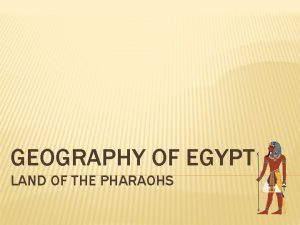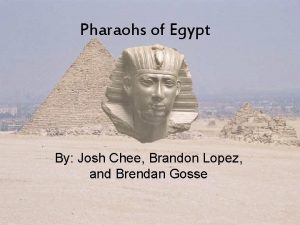Egypt Under The Pharaohs Chapter 4 Section 1




















- Slides: 20

Egypt Under The Pharaohs Chapter 4 Section 1

The World’s Longest River • The Nile is the world’s longest river. It begins in East Africa and flows about 3, 500 miles north to the Mediterranean Sea. • In Nubia and Egypt, the Nile flows through the Sahara, a vast desert that stretches across most of northern Africa. • In ancient times, the river roared through six cataracts, or groups of rocky rapids. The rocky cataracts made it impossible for people to travel by ship upstream from Egypt.

Upper and Lower Egypt • Below the cataracts, the Nile flows through a narrow valley lined with cliffs. This region is known as Upper Egypt. • The river carries silt, fine mineral particles that can form fertile soil, from its sources in East Africa. • Near the end of its journey, the Nile slows down and fans out into many streams and marshy areas. • As its slows, the river drops its silt. Over thousands of years, this silt has built up to form a larger river delta. A delta is an area of sediment, soil or minerals carried by water, deposited at the mouth of the river.

Floods and the Black Land • The rich dark soil was so important to Egyptians that they called their country Kemet, which means “the Black Land. ” • The yearly flooding of the Nile created the Black Land. Each summer, heavy rainfall in East Africa poured into the Nile’s sources. • When the floods drained away, they left behind a layer of fresh soil. • The Nile’s floods were unpredictable. If too much water came, the floods could be a natural disaster that swept away soil. If too little water came, Egypt could suffer a shortage of water. Droughts could bring hunger by causing crops to fail.

Growing a Surplus • Egyptian farmers learned to build earthen walls around fields to trap the Nile’s flood waters. • The water soaked into the soil and allowed grains such as wheat to grow. This simple form of crop irrigation allowed farmers to produce a food surplus. • Powerful people and families gained control over regions within Egypt. They were able to collect some of the famers’ surplus crop as taxes.

The Birth of Cities • The local rulers used the food surplus to buy rich cloth, jewelry, and luxury goods. These were supplied by merchants and artisans, or skilled workers who practice a handicraft. • Farmer’s production of a surplus supported these artisans. Some became full-time artisans, such as weavers or potters. • In time, settlements grew into cities. Egyptian cities brought together wealthy and skilled people. They became the centers of culture and power. Architects built impressive buildings and artists created great works of art to decorate them.

Uniting Egypt • Legends say that Narmer united the two kingdoms. This made him the first Pharaoh, or king, of a united Egypt. • He wore a double crown of red and white and founded Egypt’s earliest dynasty. A dynasty is a ruling family. • Normally, control passed between members of a dynasty. Sometimes, however, a new dynasty gained power.

Egyptian Government • The Pharaoh relied in a bureaucracy, or a system of offices and officials that handle the business of government. • The head of Egypt’s bureaucracy was an official called the vizer. • The bureaucracy collected taxes from farmers. Farmers mainly paid taxes in the form of surplus crops.

Egyptian Government • The bureaucracy took some of the food surplus for themselves. It distributed the rest to priests, to the pharaoh, and to artisans and merchants who worked for the pharaoh. • Egypt’s bureaucracy and system of taxation were a model for later governments, including those of today.

Hatshepsut • Hatshepsut was the daughter of one pharaoh and wife of another. • When her husband died, he left a son who was too young to rule. So Hatshepsut made herself Egypt’s pharaoh. • Some Egyptians did not want to bow to a women. To gain support, she carried out rituals expected of a king. • Hatshepsut dressed as a king. She even wore the false beard that was a symbol of the pharaoh’s power. Most Egyptians came to accept her rule.

Hatshepsut • Hatshepsut’s rule was peaceful. She built Egypt’s wealth and power through trade. • She sent traders by sea to a land called Punt in East Africa. They returned with precious wood, ivory, gold, and perfumes. • Hatshepsut recorded the story of their journey on the stone walls of an enormous temple that she built.

Ramses II • Ramses II built up Egypt through war. He spent the first half of his time as pharaoh fighting in Canaan and Syria, in the Fertile Crescent. • He led his army against the powerful Hittites. Ramses later made peace with the Hittites because of all the losses he suffered. They fought over each others borders. • Ramses II was a great builder. During his reign, he built more monuments than any other pharaoh.

Egyptian Society • Egyptian society was shaped like a pyramid. The Pharaoh was at the top of that pyramid. • Egyptians believed that gods controlled everything. The Pharaoh controlled Egypt, so people saw him as a god-king who deserved loyalty. • Just below the Pharaoh were nobles, priests, and officials. They helped the Pharaoh govern Egypt. So did scribes, who kept records.

Egyptian Society • Merchants and artisans made up the middle level. In Egypt, painters, stonecutters, and builders spent their entire lives working on temples and tombs. • Farmers were lower on the social pyramid. Most of the population in ancient Egypt were made up of farmers. • During the growing season, farmers raised Egypt’s food. For the rest of the year, many were required to work as laborers on the pharaoh’s building projects. Most worked willingly because they felt they would be rewarded after death by helping the god-king.

Egyptian Society • Slaves were at the bottom of the social pyramid. Many were prisoners of war or debtors who were freed from slavery after serving a period of time. • Slaves were the property of their owners and had to do forced labor.

Egyptian Religion • Religion played an important role in the life of the people of Egypt. They believed that their god controlled everything from the flooding of the Nile River to the death of a person. • Their gods could be kind or dangerous. To please the gods, Egyptians built them temples and offered them prayers and gifts.

Many Gods • Like the Sumerians, Egyptians were polytheistic. They worshipped hundreds of gods, many of whom were associated with animals. • Statues or other works of art often show a god with the head or body of a lion, a crocodile, or some other creature. • Egyptians believed that gods shared the qualities of these animals, such as their strength, speed, or bad temper.

Many Gods • One of the most important gods was Amon-Re, the sun god. Egyptians believed that Amon-Re made a daily journey across the sky. • Each night, he died in the west as the land grew dark. Each morning, he was reborn in the east as the sun rose. • Osiris was the god of the underworld, or the world of the dead. According to Egyptian legend, Osiris was killed and chopped into pieces by a rival god named Seth.

Many Gods • Isis was the wife of Osiris, and she was the mother goddess of Egypt. She moved heaven and earth to help her husband. • Isis found the pieces of Osiris’s body and brought her husband back to life. Isis represented love, caring, and protection. • Horus was the son of Isis and Osiris. Egyptian legends tell of great battles between Horus and Seth. When Horus defeated Seth, he united the two lands of Egypt. As a result, every pharaoh was thought to be Horus in human form.

Religion and Society • The belief that the pharaoh was a god on Earth contributed to the power of the pharaoh. • People obeyed the pharaoh and his officials for fear of angering a god. • Priests were also powerful, because Egyptians thought priests could help a person gain favor with the gods. • The priests of the Temple of Amon-Re in the city of Thebes were especially powerful.
 Where did the pharaoh live
Where did the pharaoh live Upper egypt and lower egypt
Upper egypt and lower egypt Richard ballinger definition
Richard ballinger definition The egypt game vocabulary
The egypt game vocabulary The egypt game chapter 1
The egypt game chapter 1 Chapter 5 lesson 3 egypt's empire
Chapter 5 lesson 3 egypt's empire The egypt game vocabulary
The egypt game vocabulary Study guide chapter 10 section 1 meiosis
Study guide chapter 10 section 1 meiosis Hát kết hợp bộ gõ cơ thể
Hát kết hợp bộ gõ cơ thể Bổ thể
Bổ thể Tỉ lệ cơ thể trẻ em
Tỉ lệ cơ thể trẻ em Gấu đi như thế nào
Gấu đi như thế nào Chụp phim tư thế worms-breton
Chụp phim tư thế worms-breton Chúa yêu trần thế alleluia
Chúa yêu trần thế alleluia Môn thể thao bắt đầu bằng chữ đua
Môn thể thao bắt đầu bằng chữ đua Thế nào là hệ số cao nhất
Thế nào là hệ số cao nhất Các châu lục và đại dương trên thế giới
Các châu lục và đại dương trên thế giới Công thức tiính động năng
Công thức tiính động năng Trời xanh đây là của chúng ta thể thơ
Trời xanh đây là của chúng ta thể thơ Cách giải mật thư tọa độ
Cách giải mật thư tọa độ

